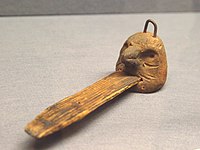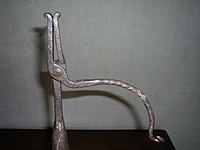Kienspan
Pine chips (also: Kienholz ) are square or flat split pieces of different lengths of resin-rich wood, mainly made of pine (also called Kienföhre, Kienbaum, torch tree or fire tree), but also from pine , spruce , alder , larch and cherry .
Manufacturing
Pine wood with excessive resin inclusions is called kienig . Pine wood is caused by an external injury to the tree bark ; the tree produces more resin to close the wound . The resin is transported to the wound, but is also deposited in the trunk, there mainly in the medullary rays . After a certain time the resin hardens, becomes crystalline and the wood cedes. If you then cut the tree and cut or chop the trunk into short pieces for all bark injuries, which in turn are split lengthwise into thin, long chips, you get the pine chip.
In Baden , pine chips were extracted from the roots of felled pine trees. In addition, the root system remained in the ground for a few years so that the rhizome could be enriched with tree resin. This was then excavated and brought into the courtyard. There the resin-soaked root wood was cut into small pieces that were tied into bundles of 10 pieces. These bundles were then sold in the neighboring cities, to restaurants, middlemen or simply from house to house. The price in the 1920s was around 5 pfennigs per bundle of pinewood, which was a lucrative income at the end of the day.
use
The pine chip is heated or lit like simple firewood and thus serves as a light source for a certain period of time. The advantage over simple fire is the fact that pine wood burns more controllably and the rate of fire can be regulated. The disadvantage is that a piece of wood only burns for about 20 minutes and the flame flickers restlessly if it is not balanced by hand at a certain angle.
history
From the Paleolithic to the 19th century, pine chips were probably the most widespread means of lighting in Central and Northern Europe ( Homer offers an early written evidence of pine chip lighting around 700 BC). Other artificial light sources ( candles , etc.) were significantly more expensive and were therefore out of the question, at least for the poorer sections of the population.
The Kien is considered to be the oldest known mine lighting in Central Europe. The first finds from the Bronze Age and Iron Age salt mining era in Hallstatt date from 1300–450 BC. However, these shavings are not keeled and are therefore usually referred to as "luminous shavings". They are made of fir and spruce wood and are completely resin-free. As a result, they do not form soot, but must be constantly moved in order to burn well. One theory is that the children of the mining company did this job.
Pine shavings were also used in funeral rites. A Kienspan was given to the deceased so that he would have a light on the way through the valley of the dead.
Pine chips were also represented in weather forecasts. When the burning pine splint cracks, it will be cold; if he has a long sniff it will thaw. If the pine wood smokes a lot while burning, wind and rain are to be expected. Braided, burning pine baskets served on the Elbe as an emergency signal when the ice fell. The meaning of the Kiens as the epitome of warmth and light is made clear by the medieval poet Konrad von Würzburg (around 1230 to 1287) in the enthusiastic Marian song "You are a Vackel and a Kien!"
Because of the strong soot development, walls and ceilings in old rooms are always heavily blackened. For this reason, light niches with their own smoke outlet were often built in brick walls for the burning pine chips. But pine chips were also a dangerous source of light, as the prominent example of the Berlin town hall shows, which burned to the ground in 1581 due to the carelessness of market master Georg Wars.
Regional distribution
Local nicknames such as that of the Bietigheimer Hardt community, whose inhabitants are nicknamed "Kienholzbuwe", or Pfeffingen on the Swabian Alb, whose inhabitants are called "Kealänder", bear witness to this time .
In the Föhrenberge Nature Park south of Vienna, where the pines are very widespread, you will often find the location Kiental , which is due to the presence of the pine wood.
In Liestal , Switzerland, the Chienbäsen parade takes place on Carnival Sunday as the highlight of the Carnival parade . Bundled pine logs weighing 20 to 100 kg are carried burning through the upper gate and driven.
literature
- Jutta Matz, Heinrich Mehl: From the pine chip to the laser beam: the history of lighting from ancient times to today . Husum, Husum 2000, ISBN 978-3-88042-968-0 .
- Hella Heintschel, Maria Dawod: lamps, candlesticks, lanterns since ancient times . Pinguin, Innsbruck / Umschau, Frankfurt am Main, 1975, DNB 760157391 , p. 34-35 .
- Walter Tillmann: Let there be light: from Kienspan, wicks, candles and lamps, lights, lamps . With drawings by Heinz Stenmans. Zimmermann, Viersen 2007, ISBN 978-3-9801898-7-3 .
Web links
- Brother fire. In: archive.is . State Office for Monument Preservation and Archeology Saxony-Anhalt , accessed on November 20, 2015 .
- Pine chip and candle. In: planet-wissen.de. www.planet-wissen.de, accessed on November 20, 2015 .
- Kienspan - natural product for lighting the fireplace. In: t-online.de . www.t-online.de, accessed on November 20, 2015 .
- Pine chip holder. The large art lexicon by PW Hartmann, accessed on September 9, 2016 .
- Find Kienspan in nature and use it to light a fire (English, German subtitles available). FYRO, accessed September 11, 2016 .
Individual evidence
- ↑ Peter Haegele: device operator. Black Forest Open Air Museum Vogtsbauernhof , Ortenaukreis, Offenburg / Gutach 1990, p. 68.
- ↑ City Lielstal: Customs. Retrieved May 19, 2017 .




